With the danger of going into and over things that have been written in many different articles over recent years, it’s worth re-visiting the popularity and intense following that fishing for squid has for many anglers.
While it’s fair to say that the majority of Victorian anglers still chase squid for a feed or when gathering bait, the pursuit of squid, or ‘egiing’ also has increased appeal for many dedicated fishers who have taken the method, and the specific tackle that can be used to the next level.
Probably the best part about fishing for squid is that it’s fun for anglers of all ages and levels of skill. It can also be done very well from simple and popular land-based areas, and even from state-of-the-art boats and kayaks, where the stealth and technology on board can be a big advantage. Catching squid would also have to be the best and most fun way to get kids involved in fishing, and they love nothing more than covering Mum, Dad and their siblings, as well as the boat and everything else with ink!
The popularity of squid fishing, and probably more importantly the constant availability of them as an inshore target species, has led to spectacular development in rods, reels and lines that are purposely built to catch squid. To go into depth on all of these advancements would fill this entire edition of VFM, but a few basic criteria sets these rods and reels aside from the rest.
True squid or ‘egi’ rods are constructed from a multi-taper blank. In simple terms, this means that the rod blank has various steps in its construction that allows the rod to aid in casting, line control, jig performance and most importantly hooking and landing squid.
Most rods also have a line and jig size rating, which means you can match your rod to your jig size and location. Reels are normally 2500-3000 size and have shallow spools designed to be spooled with thin PE braid. This larger spool size allows faster and greater line recovery, and also aids in casting distance, which can be a real advantage when casting from the bank, especially in rocky areas.
Spool handles are usually bigger too, allowing easy and faster turning when needed.
Your choice of line is just as important as the rest of the tackle, and a good quality PE line is a must. I prefer to use a high visibility colour, as this aids in detecting more subtle bites on the ‘drop’, or when your jig is not being jigged or retrieved.
Most quality Japanese manufacturers have a true egi PE line in their range, and often the easiest way to pick them from the rest is a cool little picture of a squid on the label! PE or braid lines will float on the surface, which helps a lot in achieving a good vertical retrieve for your jig, but there are also sinking styles on the market too, which are preferred by some anglers fishing strong current and deeper water.
The use of a good quality fluorocarbon leader is a must, I like to use about 2 rod lengths as a general rule, attached to the main line with a surgeons or slim beauty knot. Try to select a brand that has a little more stretch, allowing for some give in the line against the lunges of your quarry.
Of course the spin off to all this flash tackle is the accessories that are on the market, and not just jigs, but all sorts of other cool stuff as well. It’s probably worth mentioning at this stage that you can catch squid on the most basic set up, and most inexpensive jigs, but the better quality gear, and especially the jigs will perform better and catch tastier calamari more consistently. To put it into dollar terms, for a few hundred dollars you can buy a rod, reel, line and all the stuff you need to hit the water and do some serious egi damage.
A mate of mine has a theory on accessory sports, and squid fishing definitely has a big slice of stuff that you don’t necessarily need. To make things easier, I have compiled a list of all the things I reckon you need (see fact box). Also, I try to carry all this stuff in a shoulder bag so I am completely mobile, but don’t worry you can cram heaps of stuff in a good small tackle bag!
Once again, the list of techniques and ways to catch calamari will fill another edition of VFM, but there are a few very important factors that will put more squid on the bank or in the boat.
I reckon the most important criteria is working out the pace and style of retrieve that suits the day you are fishing. Often the squid will respond to a fast wind or ‘burn’, and other times a more subtle and slower retrieve is best. The best advice is to vary your retrieve to see what works. Don’t be afraid to try something weird either.
The depth that the squid are holding or feeding from is also crucial. This can be determined by scanning the reef from the bank or boat to locate your target, so a good pair of polarized sunnies is a must. Squid will also give their presence away by actively hunting bait on the surface, and leave a boil or splash in the process. A quick covering cast as quick and as close as possible will often lead to a hook up.
The sink rate of your jig is also very important. The rate of sink in metres per second is usually printed on the packaging when you purchase your jig and this is the best place to start. I do most of my squid fishing land-based in Port Philip Bay, and I prefer to have my jigs sinking as slowly as possible. To achieve this I file down the weight of the jig to get it just right. When the water is really shallow, a floating jig can also be pretty effective, but the squid can be a little tricky to hook as they will often let go of the jig when they feel the weight of your line. Recently I’ve been experimenting with this technique using topwater bream and bass lures with retro-fitted squid prongs, I’ll let you know how this goes next time.
Lastly, I reckon the time of day is also very important. Low light in particular, and tide changes and fluctuations are all key elements of your squid fishing success. I prefer to fish just before dark as the squid move into the shallows to feed, and this also coincides with when my kids are in bed, and I can whip down to my local platform for a quick session! Everyone’s a winner!
The humble calamari is a mainstay for many Victorian anglers, they taste great, make awesome bait and a great fun to catch. Make sure you clean them in the saltwater from where they were caught, and if you are fishing for a feed dispose of them quickly with an egi spike or similar device, and only take what you need.
Equipment
All you need to go ‘egiing’
• Rod/reel/line/jig
• Selection of jigs in a variety of sizes, depths and colours
• Spare line, leader, scissors, pliers
• Spray on scent (preferably with UV enhancement)
• Egi spike, jig brush
• Polarised glasses
• Plastic bags, towel
Reads: 2813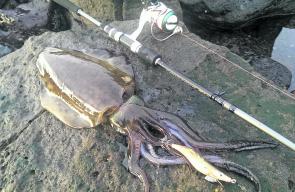
The majority of the author’s squid fishing these days is done from the bank, and while many of the squid you catch are relatively small, you can catch some ripper specimens at times, especially early and late in the day.

Squid tackle and accessories are endless and often very well designed and thought out, especially the storage boxes, tools and bags. Just like the better quality jigs, premium PE lines and leaders will greatly increase performance of your squid fishing ta
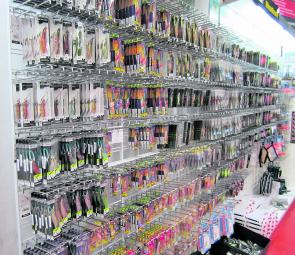
The range and colour selection of jigs at some tackle stores is massive. My advice to to stick to some key colours that you like and have them in a variety of weights and sizes.

Purpose built squid rods and reels are worth the expense if you do a lot of squid fishing, especially from the bank. They can also be used for a variety of light tackle applications. Multi taper design, and even multi piece travel options make squid fishi
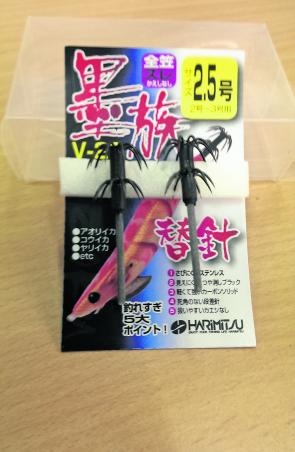
Quality replacement prongs makes restoring your best jig, or even inventing new lures of your own very easy indeed. A few drops of glue and you're on your way.
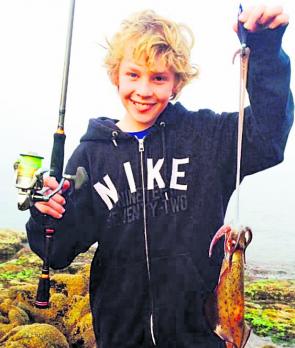
Kids love catching squid, and a good balance outfit and some quality jigs will see them landing more squid and getting covered in ink more often!
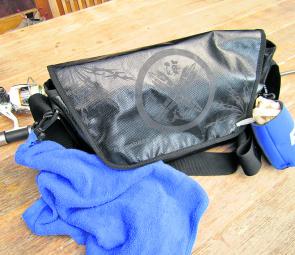
I keep all I need for a squid session in a shoulder bag and carry one rod. The most important add-ons are the towel for your hands and stubby holder full of freezer bags. Cleaning squid is a messy business, but do it where they are caught and look after y
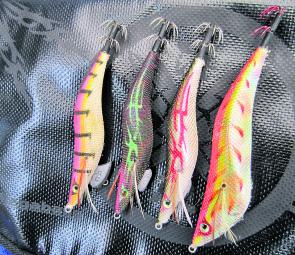
I like to alter the weight of my jigs to effectively fish different depths and tides and slow the sink rate of the jigs, even to make them float at times, for really shallow water. This can be done very easily with a small file, but be careful of those sh

The success of floating jigs at times has caused me to experiment with some surface lures and retro-fitting them with squid jig prongs. This idea is far from proven or tested, stay tuned for more information.




